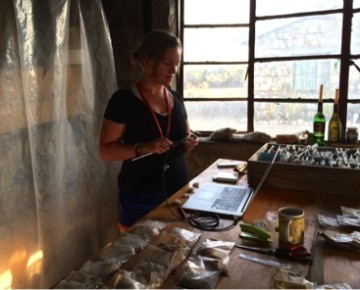It is no secret that Olduvai Gorge has yielded many of the most important discoveries in human evolution, from the type specimen of Homo habilis and Paranthropus boisei to the nearby Laetoli footprints. Throughout the years, archaeologists have spent thousands of dollars taking fossils and artifacts out of the ground. Have you ever wondered what happens to those specimens after they are studied? Probably not. And that’s a problem.
I’ve been living at Olduvai for the past six weeks studying collections that were excavated in the 1970s. I live in a small tin-roofed cabin originally inhabited by Mary Leakey. My sustenance consists of Africáfe and rice and beans. My closest friends are my Masai neighbors and two dogs who live in camp. Giraffes, oryx, dik dik and guinea fowl don’t notice me anymore when they pass by each day in search of food. Every morning I wake up with the sun and spend 8 hours a day, calipers in hand, studying artifacts. Living in “the bush” is not new to me, but being mostly alone here has given me ample time to think.
Surprisingly, the idea that consumes my mind most is not the fact that hyenas are howling nearby at night, or that millions of years of human evolution are recorded in the layers of earth that surround me. Rather, I am concerned most with what many in our field consider an afterthought—collections management.
“Material cultural remains without context is trash. Literally.”
The assemblage I am studying was excavated by a meticulous archaeologist who carefully recorded all 280,000 artifacts that came out of the ground. The problem? He left in the middle of analysis due to an emergency and never returned. At the time, there was no “system” in place to ensure the safety of the collection after his departure.
While it is still possible to study the artifacts, it is clear that some are missing, and some have no provenience information—the context in which the artifact or fossil was found, for example the trench, square, and depth. Without this information, the artifact or fossil is robbed of any evolutionary significance. With no idea from where or whence it came, it might as well be used as a doorstop.
Opportunities Abound
We as researchers stand as the first ‘line of defense’ for protecting cultural heritage. In this vein, I am essentially re-curating the collection as I study it, with new bags, cards, and trays. I quickly realized this was way too much work for one person. Thus when a young Masai guy came into the lab and said he wanted to learn about rocks, I took the opportunity. I have been training William on all things lithics and geology, with three lectures a week. In return he is helping me go through each jerry can and place the artifacts into a system, and he is quickly learning the ropes in curation and collections management. We are moving along, slowly but surely, and it is rewarding to see the progress. But this is just one collection, at one site, and we are only two people. What about the issue at large?
Coincidentally, Olduvai is in the middle of a huge structural change. After decades of being under the jurisdiction of the Department of Antiquities, cultural heritage in the area is getting a makeover thanks to the Ngorongoro Conservation Area Authority (NCAA). Just this year, the NCAA started a new office of Cultural Heritage, and it is assuming most of the responsibilities associated with antiquities, including the Site Museum. The NCAA is similar to a national park in that wildlife abound, including the annual wildebeest migration, but it is different from a park in that people live here, as well as their livestock. It remains to be seen what changes NCAA will bring for cultural heritage management, but I am hopeful that this change will herald a new approach to collections management at Olduvai and the surrounding region. I am especially hopeful that it will create new jobs and bring much needed revenue to the people who have lived here the longest—the Masai. Through collaboration between local Masai, the NCAA, and researchers like me, we can ensure that Olduvai’s fossils and artifacts are preserved for generations to come.



